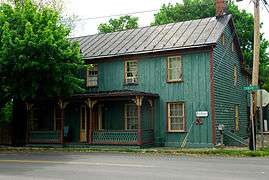Middleway, West Virginia
| Middleway | |
|---|---|
| Census-designated place (CDP) | |
 Middleway Location within the state of West Virginia | |
| Coordinates: 39°18′12″N 77°58′58″W / 39.30333°N 77.98278°WCoordinates: 39°18′12″N 77°58′58″W / 39.30333°N 77.98278°W | |
| Country | United States |
| State | West Virginia |
| County | Jefferson |
| Area[1] | |
| • Total | 1.123 sq mi (2.91 km2) |
| • Land | 1.123 sq mi (2.91 km2) |
| • Water | 0 sq mi (0 km2) |
| Population (2010)[2] | |
| • Total | 441 |
| • Density | 390/sq mi (150/km2) |
| Time zone | Eastern (EST) (UTC-5) |
| • Summer (DST) | EDT (UTC-4) |
Middleway is a census-designated place (CDP) in Jefferson County, West Virginia, United States. As of the 2010 census, its population was 441.[2]
History
On January 15, 1786, the Virginia General Assembly passed an act establishing the town of Smithfield on land owned by John Smith II and William Smith. A post office was established in 1806; and since there was another town called Smithfield in the state, a different name was needed to avoid confusion. Because Smithfield had become a center of commerce between several other towns, the post office became known as "Middleway." Middleway remains a small village and retains many of its historic buildings. The Middleway Historic District was added to the National Register of Historic Places in 1980.
The area where the town grew was apparently first visited by John Smith I and his sons John Smith II and Rees Smith in 1729. By 1734 they had established a grist mill and a hemp mill. In the 1790s, in an effort to increase the town, the Smithfield Promotion was undertaken. This did increase the size of the town, but it stagnated from then on.
The town has also been known as "Wizard Clip" or "Clip", and townspeople as "Clippers". This is the result of a legend from the 1790s, in which a traveler lodged with Adam Livingston and his family. During the night, the traveler died, calling for a priest, though Livingston refused to let a Catholic priest enter his home. After the stranger's burial, Livingston saw various disturbing supernatural phenomena: heads and legs falling off chickens, all the crockery spontaneously falling to the floor, etc. The most common experience was a constant clipping sound, like that of scissors, pervaded the house, giving the legend its name. Anyone entering the house had their clothes cut into tatters or half-moon crescents. Livingston dreamed of a priest, and found in Shepherdstown Father Dennis Cahill, a Catholic priest who appeared in his dream. This priest exorcised the spirit and the family converted to Catholicism. Afterwards they would frequently hear a disembodied voice who provided advice, tell them to pray, and told them to be better Catholics.[3]
Historic Buildings and Structures
Photo Gallery
- Middleway Historic District
- Grace Street
 Half-Moon Crescent Symbols
Half-Moon Crescent Symbols The Daniel Fry House on Queen Street
The Daniel Fry House on Queen Street Half-Moon Crescent Symbols
Half-Moon Crescent Symbols
Google Earth Placemark
References
- ↑ "US Gazetteer files: 2010, 2000, and 1990". United States Census Bureau. 2011-02-12. Retrieved 2011-04-23.
- 1 2 "American FactFinder". United States Census Bureau. Retrieved 2011-05-14.
- ↑ James E. Harding (October 23, 1979), National Register of Historic Places Nomination: Middleway Historic District (pdf), National Park Service
